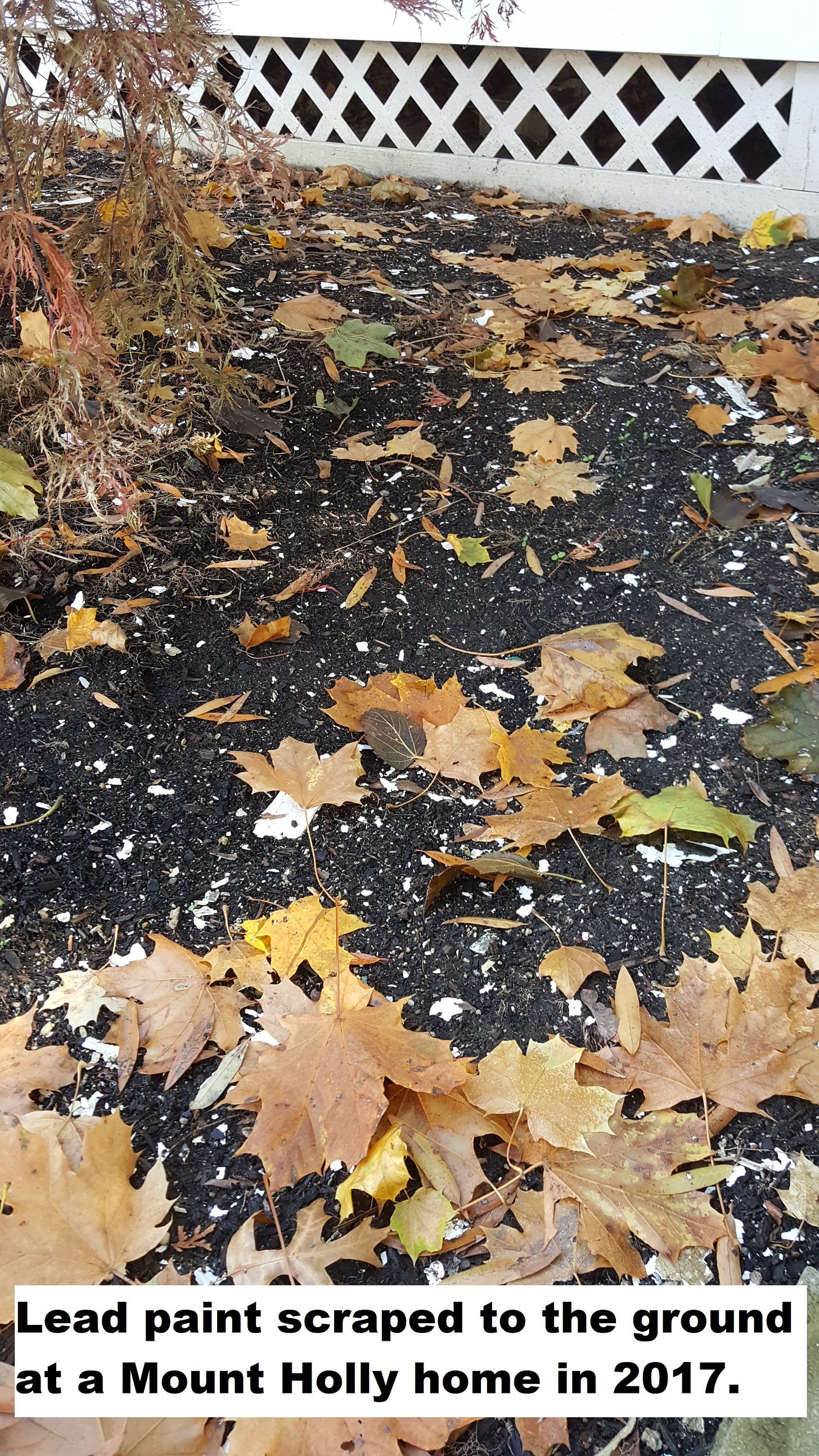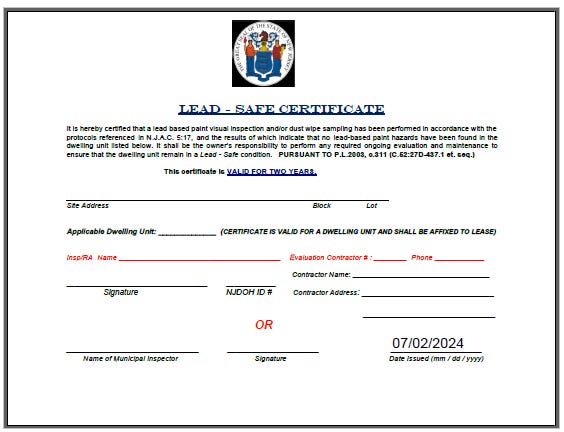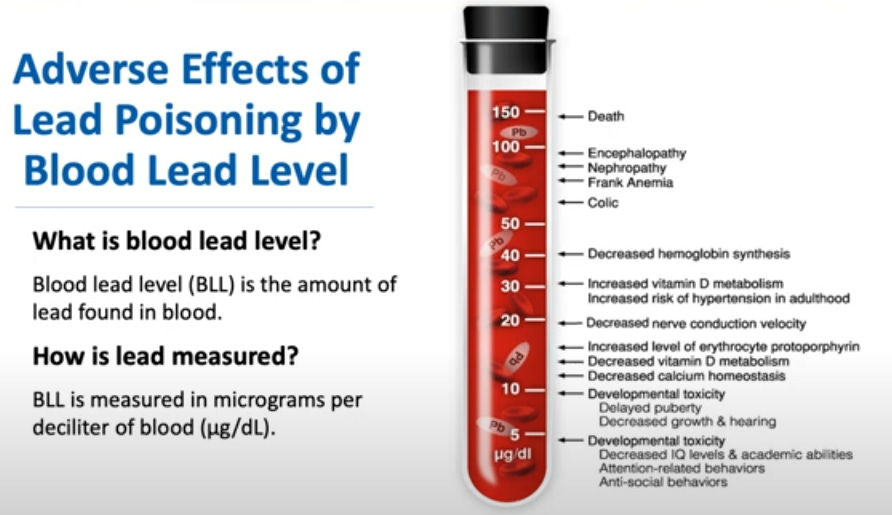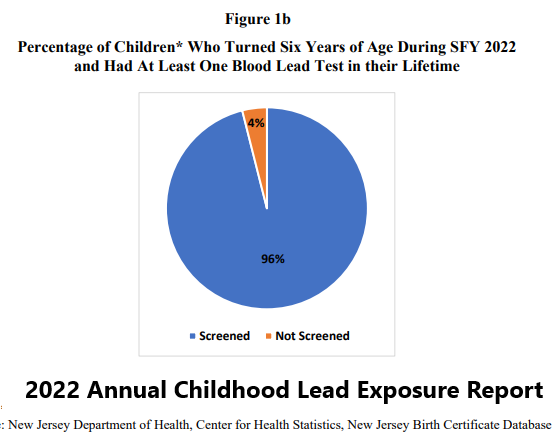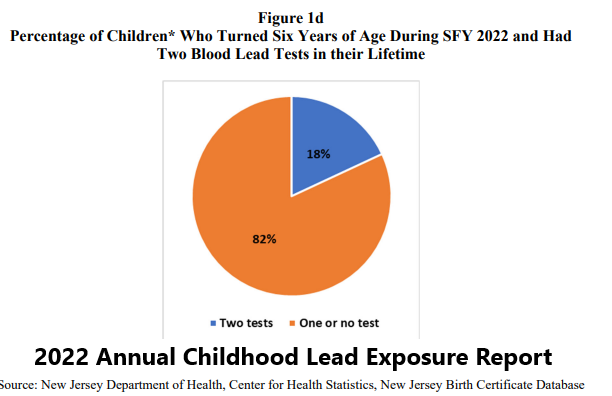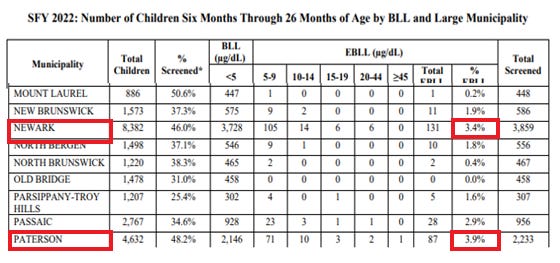Its Not Just Water. Lead is Everywhere
Mount Holly Housing Stock and the Lead Crisis in America
We have a lead problem.
Say “lead poisoning” and many will think of the Flint Michigan water disaster, which is still unresolved. Encouragingly, the water problem in New Jersey is being solved through a small fee on our water bills that provides funding to enable water companies to remove all of the lead and galvanized “service lines” on the homeowner side of the water meter. This removal, generally the responsibility of the homeowner, is free to the customer aside from the monthly fee that everyone pays. Water companies are on target to complete this work by 2031.
If you want to know more about that work, see https://www.themounthollyreporter.org/p/njaw-getting-the-lead-out .
But solving the lead crisis for water is, unfortunately, just a warm up for the more difficult, widespread and VERY expensive lead exposure problem found in our homes.
Housing built before 1978 is often covered in layers of lead paint on doors, moldings, cabinets and, most threateningly, windows. That’s because the frequent opening and closing of lead painted windows can act like a paint grinding mill in the house. The abrasive movement of painted surfaces against one another produces a fine dust that settles on window sills, floors and furniture.
The majority of Mount Holly's housing stock was built before 1978, so the percentage of Mount Holly homes with some amount of lead paint inside [and outdoors] is much higher than the newer construction in towns like Mount Laurel.
Speaking of outdoors issues, neighborhood painting projects too often feature a scraping phase that sheds paint chips like snow onto bare ground where it nestles into the mulch, shrubs and gets blown by wind and washed by rain into the street and streams.
Want to know more about outdoor paint contamination?
See https://ehp.niehs.nih.gov/doi/abs/10.1289/ehp.5761
Laws exist that could be used to stop this behavior, but government bodies seem unwilling to use those laws to enforce or even to routinely inform homeowners of the law. True, enforcement of the full USEPA lead containment technique on homeowners would be onerous, but if owners were just instructed to tarp the ground, it would significantly reduce the problem for painting projects. Unfortunately, even this modest effort is often more than many are willing to do voluntarily.
NJ MANDATES LEAD TESTING IN RENTALS
While existing laws against discharging lead paint to the environment are mostly not enforced, the state and local government are strictly enforcing the new lead testing law for rentals. New Jersey already took an important step during 2024 when its deadline arrived for lead testing of all rental units. Landlords had to either pass the tests or forfeit their rental license.
That means that tenants who move into housing which has lead paint receive an assurance, in the form of a Certificate, that the unit was determined to be safe when sampling was conducted.
But that safety rating has a two year expiration date, because the cleaning and latex “paint-encapsulation” measures used to pass the test eventually fail once windows, drawers and doors are moving again under the normal living conditions. So, while the law is a useful means to determine if a house is safe at the time of testing, any encapsulated lead hazard will remain in place, and the same safety testing must be repeated every two years.
SCOPE OF THE PROBLEM
All of these exposure scenarios are a threat to human health. But it’s our playful, curious children who are most at risk.
This story will center the health of children, but it needs to begin [and end] with historic housing, and more specifically the expense of remediating lead in buildings.
Number Of Units With Lead Hazards
A 2002 article published by the National Institutes of Health, noted that “38 million housing units had lead-based paint, down from the 1990 estimate of 64 million. Twenty-four million had significant lead-based paint hazards.”
Mortgage lender JP Morgan says 41% of our nation’s 50 million rental units [about 20 million units] are managed by middle class “Mom and Pop” landlords. Millions of these units have lead paint hazards.
Financial Cost of Remediation
Replacing just the lead painted windows on a large historic Mount Holly home with about 30 windows could easily exceed $50,000. A medium sized home with about 15 windows would approach $30,000. [These figures are for a standard construction contractor, not the more expensive remediation contractors]. If we consider the 24 million units noted above and remediate just $10,000 worth of windows in each, the replacement cost at the national scale could exceed $240 billion dollars for just windows.
This cost may sound like an exaggeration. Some may say encapsulation is the cheaper answer, but, as noted above, encapsulation inevitably fails because it leaves lead paint in place. Perhaps far cheaper replacement costs could be achieved. Maybe economies of scale could change the calculations. But whatever set of assumptions and calculations you use, the cost of national lead remediation would be stupendous.
And for most middle class homeowners, including landlords, absorbing the cost of a total house lead abatement is very difficult at best. A decade[s] long replacement plan could be achievable, but leaky roofs, clogged plumbing, broken appliances and other life priorities tend to eclipse the silent emergency of lead abatement.
Which explains why the problem is still with us.
HEALTH THREAT OVERVIEW
State law mandates testing for lead in children before they are six:
“A physician shall perform lead screening on each patient under six years of age to whom the physician provides health care services” N.J.S.A 26:2-137.4
Did you know that more than 3% of kids tested for lead in Mount Holly had a blood lead level [BLL] of at least 5 micrograms per deciliter [ug/dl]? We know that only because the State of New Jersey Department of Community Affairs “mandated” that Mount Holly use the “dust wipe” test for lead in apartments; state law requires “dust wipe” sampling in rental units that are located in a municipalities where 3% of children have a BLL greater or equal to 5 ug/dl. See image below.
There is no known safe concentration of lead in blood, but the Center for Disease Control [CDC] published guidance which settled on a blood lead level of 3.5 micrograms of lead per deciliter (μg/dL) as its lowest level of concern. Further, two consecutive results of over 10 micrograms of lead per deciliter (μg/dL) requires that the local Health Department "shall provide for case management of the child" which includes "a home visit" that is required within specific schedule depending on the BLL.
The slide below was presented by the CDC and gives a sense of what types of health outcomes arise versus various BLL concentrations.
LEAD TESTING COMPLIANCE FOR KIDS
While some vaccinations are required for entry to school, lead poisoning is not contagious, so there is no test requirement to enter school. That reduces the pressure for testing compliance. Instead, the testing requirements are focused on your health provider. Physicians are directed to test patients once prior age 1 and another time before age 2.
The compliance level in New Jersey for one test by age three is 78%. The compliance level for kids of six years age having one test is 96%.
But compliance with that second test drops way off. The rationale for not getting the second test could be that a doctor may recommend the “required” 2nd test, but did not insist that the parent follow up because
the kid had a good first test, and
the kid is now past the “hand to mouth” phase, and
the housing is known to have no paint and water problems, and
the kid has no behavioral signs of concern.
The annual report of the New Jersey Department of health for Childhood Lead Exposure shows that compliance with the second test requirement was only 18%.
THEORETICAL PREDICTIONS REGARDING EXPOSURE
The Brookings Institute published an article regarding what researchers believe lead exposure does to the people who were exposed as children. They said that “The ‘lead-crime hypothesis’ is that: Lead exposure at young ages leaves children with problems like learning disabilities, ADHD, and impulse control problems; and those problems cause them to commit crime as adults — particularly violent crime.”
See https://www.brookings.edu/articles/new-evidence-that-lead-exposure-increases-crime/
Lead poisoning can cause terrible lifelong disability to children even when the exposure is known to parents and an intervention is done promptly. But there is also the reality of undiagnosed kids with an “Invisible Illness” that can eventually ruin their lives and cause society to incarcerate stricken individuals who commit tragic crimes. This is why early testing is critical.
Salt and Light Company of Westampton manages the Lead Paint Remediation and Abatement Program (LRAP) in Burlington County for the New Jersey Department of Community Affairs.
See Youtube video
An excerpt from that Salt and Light video cited national figures on the impact of lead entering the bloodstreams of children.:
Finally, what the statistics from the NJ Department of health reveal is that populations in lower income areas like Newark suffer the highest percentage of children with lead poisoning.
See https://www.nj.gov/health/childhood-lead/documents/childhood-lead-2022-annual-report.pdf
WHERE DO WE GO FROM HERE?
Back in the 1970s we recognized a national problem with hazardous waste sites. National leadership created a federal “Superfund” law on December 11, 1980 to deal with sites where a responsible party could not or would not act. New Jersey acted in 1976 to create a similar law called the Spill Compensation and Control Act, which had a “Spill Fund”. These funds were created by that dirty word: Taxes. But they achieved cleanups of environmental disasters that would otherwise still be haunting us.
We are in a similar predicament now with millions of lead tainted buildings across the country, some of them right here in Mount Holly. The problem is too big for most middle class individuals to handle in a timely fashion based on self-financing or standard commercial financing.
If society is serious about tackling the lead problem before it injures more kids and results in crime and incarceration, lead abatement has to be seen as another national environmental crisis.
As you will see below, the state of New Jersey has at least partially addressed the problem by acquiring a 180 million dollar federal grant for lead remediation. On June 7, 2024, the Department of Community Affairs [NJDCA] announced that Westampton based Salt and Light Company was awarded $2 million to address lead-based paint remediation and abatement in south Jersey.
Bob Higgs of Salt and Light said the “Lead Paint Remediation and Abatement Program" (LRAP) program is targeted to “Homeowners or tenants in single-family, duplex, and small apartments that are affected by lead. The income of the tenant, not the landlord, is what determines eligibility. We strongly encourage landlords who have low and medium-income tenants to contact us about the program." To qualify, the applicant must meet gross income requirements of less than or equal to 80% of the county median income. Higgs said that for Burlington County that’s “$66,850 for a single person, $76,400 for two people, $85,950 for three and $91,000 for four”.
Higgs added that “LRAP isn’t meant to modernize the whole house. There are other state programs for that, like the Weatherization Assistance Program”, which is also targeted to lower incomes. But Higgs said that if an applicant qualifies for LRAP, “our program will pay up to $13,000 to significantly reduce lead levels in the home”.
Higg’s noted that the $13,000 limit on LRAP “remediation cases” is increased to $30,000 where a child is discovered to have an actual lead health impact.
Where a health impact has been documented, the response is called “lead abatement”. These are more extensive interventions that seek to remove more lead covered materials. “Friction surfaces” like windows and doors are especially targeted, but also chipped/cracked surfaces and surfaces accessible to children.
With regard to these abatement scenarios, Higgs said “some Community Development Block Grant (CDBG) funding for remediation has been made available to Burlington County as a whole as well as municipalities which elected to pursue their own separate grants. As a result, Salt and Light was able to help one homeowner for whom the cost of remediation was in excess of $30,000. Both LRAP and CDBG funding paid for the work.”
While this mitigates lead exposure for some low-income applicants, Salt and Light’s current grant funding is capped at 100 housing units in Burlington County.
NECESSARY BUT NOT ADEQUATE
The Mount Holly Reporter concludes that the State has limited resources and that it made a tactical decision to use those dollars to target the low-income populations who experience the highest percentage of harm. Unfortunately, the dollar amounts allocated are inadequate for even that task and the State’s “means testing” policy completely excludes middle class individuals who also experience harm, albeit at lower percentages.
Clearly more money is needed to right-size the program.
WHERE WILL WE GET THE MONEY?
A couple of sectors to look to for a modest tax aimed at funding lead abatement are the paint industry [the North American paint and coatings market is expected to reach $20 billion by 20251] and the window and door industry [estimated at $27 billion in 20232].
Assuming New Jersey has a 1/50th share of those figures and a 2% tax was levied, the state could raise about 20 million a year for a lead abatement program.
How the fund could be used would be up to the Legislature, but some ideas are: zero interest loans with a 5 or 10 year pay-back period, and/or rebate programs that might finance some portion of a lead mitigation project.
What would that tax mean for people at the store buying things for renovations? It would be a $100 tax on a $5000 purchase. Some will debate whether such a tax is worth it, but what is clear at this point is that middle class people also need support with the giant problem of lead in our communities.
So while we are actually addressing the highly publicized lead pipe problem, the lead paint problem is the elephant in far too many rooms. Unlike water, where the resolution for a house is deemed to be removal of a single pipe, lead paint is present on many separate surfaces. Removing all these sources from a home is not only more difficult than removing a pipe, it is orders of magnitude more expensive. But the harms caused by lead poisoning are equally huge and will continue to haunt all of us in terms of damaged lives, crime and the incarceration costs. Solving this problem by paying a few extra dollars on paint, doors and moldings would appear to be a bargain.
1. https://wifitalents.com/painting-industry-statistics/
2. https://www.grandviewresearch.com/industry-analysis/us-windows-doors-market-report





